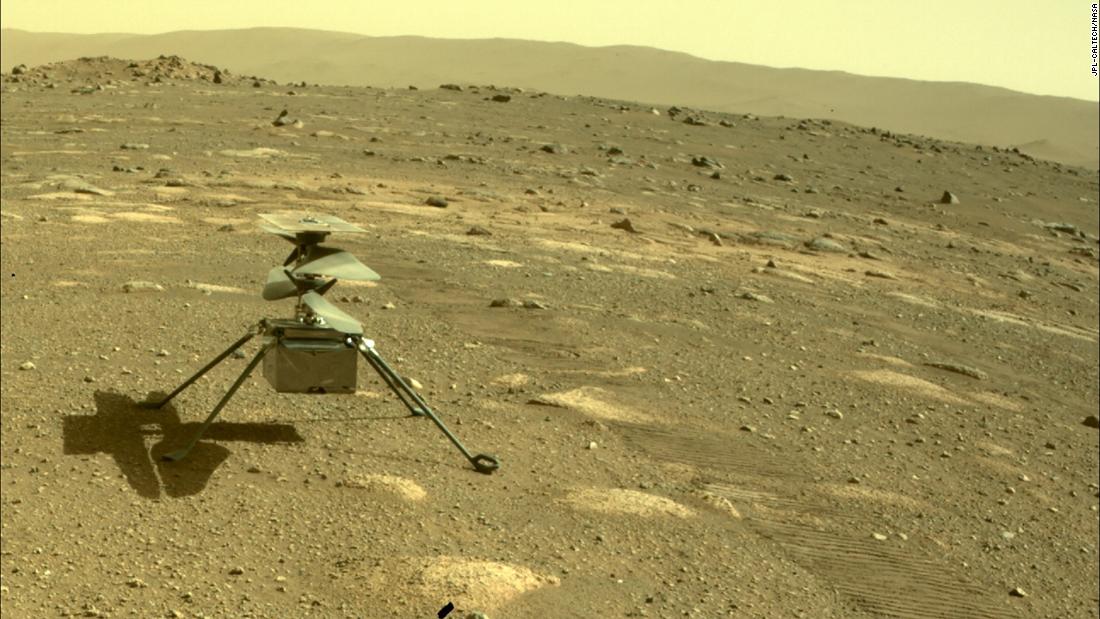This is NASA's image of the week from Mars 0:40
(CNN) -
The Ingenuity helicopter survived its first night on the icy surface of Mars, a major milestone in the aircraft's journey before its historic first flight.
The temperature in Jezero Crater, a former lake bed on Mars and the current site of the Perseverance rover and the Ingenuity helicopter, can drop to -90 degrees Celsius.
That's low enough to cause significant damage to the helicopter's battery and electrical components.
The 2kg helicopter finally separated on April 3 from the belly of the Perseverance rover, where it has been hiding since before the rover was launched from Earth in July.
Ingenuity went through a series of movements to deploy from underneath the rover, what looked like the metamorphosis of a butterfly, before dropping the last 10 centimeters to the Martian surface.
Swing low, sweet helicopter… @ NASAPersevere is slowly and carefully deploying the #MarsHelicopter, Ingenuity.
The tech demo is currently unfolding from its stowed position and readying to safely touch down on the Martian surface.
See upcoming milestones: https://t.co/TNCdXWcKWE pic.twitter.com/3AyaiHOH2k
- NASA JPL (@NASAJPL) March 30, 2021
advertising
"This is the first time that Ingenuity has been alone on the surface of Mars," MiMi Aung, Ingenuity project manager at NASA's Jet Propulsion Laboratory in Pasadena, California, said in a statement.
“But now we have confirmation that we have the proper insulation, the proper heaters and enough battery power to survive the cold night, which is a great victory for the team.
We are excited to continue preparing Ingenuity for its first flight test. "
READ
: The Ingenuity helicopter will explore Mars: this has been the historic trip to fly on another planet
The next feat is flight
When Ingenuity flies, which could happen as early as April 11, it will be the first powered, controlled flight on another planet.
In a nod to the first such feat on Earth, Ingenuity carries a fabric swatch from the Wright brothers' plane, Flyer 1.
Ingenuity, the first helicopter sent to Mars, presented a challenge to the engineers who designed it for several reasons.
It had to be small enough to fit underneath the rover without jeopardizing the Perseverance mission, which is the first to look for evidence of ancient microbial life on Mars.
Ingenuity also had to be lightweight to fly through the Martian atmosphere, which has only 1% of the atmosphere present on Earth.
This, while still having enough power to warm up and survive the frigid Martian nights.
The thin nature of Mars' atmosphere makes it more difficult to generate lift and rise.
Ingenuity helicopter hits the ground on Mars 1:23
Shortly after Perseverance deposited Ingenuity at the center of its airfield, the rover moved away from the helicopter.
This allowed the helicopter's solar array to collect critical sunlight.
Perseverance sent images of the helicopter's four legs on the surface on April 4.
The helicopter blades, currently stacked on top of each other, will be deployed on April 7.
The mission team on Earth will send commands to the helicopter to "wag" the blades.
The helicopter also needs to go through some checks on its computers, which will help Ingenuity fly autonomously through the Martian atmosphere.
Now that Ingenuity is not borrowing power and heat from the rover, the helicopter will send information on the performance of its power and thermal control systems for the next two days.
This will allow the helicopter team to configure the necessary settings to ensure that Ingenuity survives the next 30 days of its mission.
Technology demonstration
Ingenuity is a technology demonstration, which means its mission is short compared to the rover's two-year plan to explore Jezero crater.
Now that the helicopter is on the Martian surface, it has 31 Earth days, or 30 Martian Suns, to perform up to five test flights.
During the first flight, the helicopter will attempt to rise about 3 meters into the air from the center of its flat 10-by-10-meter airfield, turn, and touch down again.
The test should take about 30 seconds.
Future flights will test the helicopter's ability to fly higher and longer.
Meanwhile, the Perseverance rover will sit on a nearby lookout and watch the flight, capturing images, video and audio.
These will arrive on Earth in the days after the first flight.
READ
: NASA shares the first video and new images of the Perseverance rover on Mars
Once Ingenuity's journey comes to an end, the rover will focus on its science mission and begin studying rocks and collecting samples that will be returned to Earth on future missions.
"Our 30-sun test program is moving forward with exciting milestones," said Teddy Tzanetos, deputy director of operations for the Ingenuity helicopter on Mars at JPL, in a statement.
"Regardless of what the future holds, we will acquire as much flight data as we can within that time frame."
InstaNewsMarte

